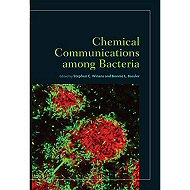|
Chemical Communication among Bacteria
|
|
Edited by: Stephen C. Winans and Bonnie L. Bassler
|

|

From the Preface
Although a few groups of bacteria have long been known to communicate via diffusible chemical signals, we are only now learning that this process is enormously widespread. We are now in a position to begin to appreciate the importance of cell-cell communication in areas as fundamental as bacterial physiology, ecology, evolution, and pathogenesis. […] We hope readers of this new volume will agree that an enormous amount of information on major aspects of signaling has surfaced since that first book was published and that a fresh view of the topic is now appropriate and important for a diverse audience of researchers, educators, and clinicians.
The past decade has witnessed new insights about the chemical composition, synthesis, and turnover of a variety of bacterial signal molecules. First, the enzymes that synthesize signal molecules are far better understood than they were 10 years ago. At the close of the 20th century, no signal synthase had been studied at the structural level. Currently, the structures of three bacterial signal synthases have been solved, two of which produce AHLs (chapter 16) and one of which synthesizes AI-2 (chapter 19). In other developments, the Streptomyces coelicolor 15-residue SapB peptide, required for aerial fruiting body formation, is now known to be synthesized by a nonribosomal peptide synthase (chapter 6). We recently learned that at least one class of extremely hydrophobic signal travels as a component of vesicles derived from the cell outer membrane (chapter 20). This signal, designated PQS (Pseudomonas quorum signal) also has antimicrobial properties against gram-positive bacteria. Many new types of signal molecules with a variety of novel structures are under study, including polyamines, rhamnolipids, and metabolites such as indole and amino acids (chapters 3, 7 and 17). During the past decade, a variety of enzymes capable of degrading bacterial communication signals have been described, as well as natural and synthetic small molecules that agonize or antagonize signaling (chapters 10, 24 and 25). Future studies may help us understand whether the substrates for which these enzymes were selected are signaling molecules or whether the destruction of signal molecules in incidental to activity for which they were selected. […]
|
|
